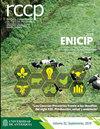厄瓜多尔牛群中与牛白血病病毒(BLV)血清阳性相关的血清流行率和危险因素
IF 0.5
4区 农林科学
Q4 AGRICULTURE, DAIRY & ANIMAL SCIENCE
引用次数: 0
摘要
背景:牛白血病病毒(BLV)是牛地方性白血病(EBL)的病原体。这种疾病主要影响牛,给生产者造成严重的经济损失。目的:建立厄瓜多尔乳牛和两用牛群的个体和群体血清阳性率,确定与BLV血清阳性相关的危险因素。方法:采集386头牛的2668份血清样本。每个牧群都完成了一份问卷,其中包括与牛的健康、管理和环境有关的变量。采用商业阻断酶联免疫吸附试验(ELISA)检测血清阳性。建立了广义估计方程模型(GEE)来确定与BLV血清阳性相关的因素。结果:厄瓜多尔BLV感染个体血清阳性率为17.3% (CI95% = 15.86 ~ 18.74%)。兽群患病率为37.8% (CI95% = 33.0-42.6%),兽群内患病率为12.5 - 100%(中位数:37.5%)。与BLV血清阳性相关的危险因素是人工授精(OR: 2215;CI95% = 1.402-3.501),混凝土地板(OR: 2.178;CI95% = 1.217-3.889),野生反刍动物的存在(OR: 2.998;CI95% = 1.788-5.027),采样季节(湿期;OR: 1.996;(95% = 1.140-3.497)。结论:结果表明,BLV在厄瓜多尔牛群中广泛存在。此外,该研究表明,对抗BLV感染的控制计划应侧重于控制已确定的危险因素。本文章由计算机程序翻译,如有差异,请以英文原文为准。
Seroprevalence and risk factors associated with bovine leukemia virus (BLV) seropositivity in cattle herds from Ecuador
Background: Bovine leukemia virus (BLV) is the causative agent of enzootic bovine leukosis (EBL). This disease mainly affects cattle, causing severe economic losses to producers. Objective: To establish individual and herd seroprevalence and determine the risk factors associated with BLV seropositivity for dairy and dual-purpose cattle herds in Ecuador. Methods: A total of 2,668 serum samples from 386 herds were collected. A questionnaire, including variables related to cattle health, management and the environment was completed by each herd. A commercial blocking enzyme-linked immunosorbent assay (ELISA) test was used to determine seropositivity. A generalized estimating equation model (GEE) was developed to determine the factors associated with BLV seropositivity. Results: Individual seroprevalence of BLV infection in Ecuador was 17.3% (CI95% = 15.86-18.74%). Herd prevalence was 37.8% (CI95% = 33.0-42.6%), and intra-herd prevalence ranged between 12.5 and 100% (median: 37.5%). The risk factors associated with BLV seropositivity were artificial insemination (OR: 2,215; CI95% = 1.402-3.501), concrete floors (OR: 2.178; CI95% = 1.217-3.889), presence of wild ruminants (OR: 2.998; CI95% = 1.788-5.027), and sampling season (wet; OR: 1.996; CI95% = 1.140-3.497). Conclusions: Results indicate that BLV is widespread in cattle herds in Ecuador. In addition, the study suggests that a control program to fight BLV infection should focus on controlling the risk factors identified.
求助全文
通过发布文献求助,成功后即可免费获取论文全文。
去求助
来源期刊

Revista Colombiana De Ciencias Pecuarias
AGRICULTURE, DAIRY & ANIMAL SCIENCE-
CiteScore
0.80
自引率
0.00%
发文量
18
审稿时长
6-12 weeks
期刊介绍:
The editors of Revista Colombiana de Ciencias Pecuarias (RCCP) welcome the submission of original manuscripts on experimental and clinical studies associated with the broad areas of animal sciences and veterinary medicine as they interface with biochemistry, molecular biology, physiology, pharmacology, toxicology, pathology, microbiology, parasitology, immunology and epidemiology. The scope of the journal includes studies of basic and applied research in animal management and production, feeding and nutrition, reproduction, breeding, genetics, animal welfare and behavior; as well as animal production focussed from biotechnology, soil science, agrostology, silvopastoral systems, livestock economics and the environment.
The criteria for acceptance of papers submitted for publication are originality, quality and clarity of the content. Each contribution must be based on original, unpublished research that has not been simultaneously submitted to other journals. All papers will be peer reviewed. All authors bear responsibility for ensuring the integrity and quality of their reported research. It is the author''s responsibility to secure permission to use figures or tables that have been published elsewhere.
Contributions may be classified as original research, review, rapid communication, clinical case studies or methodological articles, as well as news/commentaries or letters to the editor. Most review articles are invited by the editor. Authors interested in submitting a review article should contact the corresponding editor. Rapid publication of original manuscripts is a goal of the journal. Manuscripts must be written in English. Each manuscript is considered for publication with the understanding that it has not been simultaneously submitted to any other journal. Upon acceptance for publication, papers are subject to editorial review and revision.
 求助内容:
求助内容: 应助结果提醒方式:
应助结果提醒方式:


